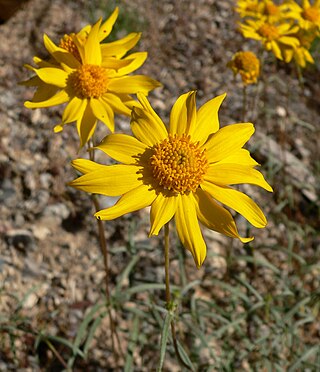Ageratina sodiroi is a species of flowering plant in the family Asteraceae. It is endemic to Ecuador, where it is widely distributed in the Andes.
Clibadium sodiroi, is a species of flowering plant in the family Asteraceae. It is native to Colombia and Ecuador. In Ecuador, its natural habitats are subtropical or tropical moist lowland forests and subtropical or tropical moist montane forests.
Critoniopsis sodiroi is a species of flowering plant in the family Asteraceae. It is found only in Ecuador. Its natural habitat is subtropical or tropical moist montane forests. It is threatened by habitat loss.
Erato sodiroi is a species of flowering plant in the family Asteraceae. It is found only in Ecuador. Its natural habitat is subtropical or tropical moist montane forests. It is threatened by habitat loss.
Aldama media is a species of flowering plant in the family Asteraceae. It is found only in Ecuador. Its natural habitat is near saline lakes, growing in dry forests, scrublands and grasslands. It is threatened by habitat loss.

Viguiera is a genus of flowering plants in the family Asteraceae. It contains around 19–40 species, which are commonly known as goldeneyes and are native to the New World. These are herbs to bushy shrubs that bear yellow or orange daisy-like flowers.
Axinaea sodiroi is a species of plant in the family Melastomataceae. It is endemic to Ecuador. Its natural habitat is subtropical or tropical moist montane forests.
Palicourea sodiroi is a species of plant in the family Rubiaceae. It is a shrub and grows primarily in wet tropical habitats. It is endemic to Ecuador.
Pitcairnia sodiroi is a species of plant in the family Bromeliaceae, it is a perennial and epiphyte. It is endemic to Ecuador. Its natural habitat is subtropical or tropical moist montane forests. It is threatened by habitat loss.

Luis Sodiro (1836–1909) was an Italian Jesuit priest and a field botanist from Vicenza who described a large number of species from the area around Quito, Ecuador in the early 20th century. He was perhaps the first person who collected in this region and he described at least 38 species from Esmeraldas, a region in Ecuador.

Heliomeris is a genus of flowering plants in the family Asteraceae, known generally as false goldeneyes.

Aldama is a genus of flowering plants in the family Asteraceae. The native range of this genus is tropical & sub-tropical America. The genus was originally described to include one species of subtribe Helianthinae that were characterized by having pales that tightly enclosed the cypselae (achenes).
Rhysolepis was a genus of Mexican plants in the tribe Heliantheae within the family Asteraceae. Until 2011, when botanists Schilling & Panero studied the subtribe Helianthinae based on molecular sequences of nuclear ITS, ETS, and cpDNA, coming to a conclusion that that the genus ViguieraKunth, did not constitute a monophyletic group. Among their conclusions they proposed to reclassify the genus, dividing and relocating its species in at least eleven genera: AldamaLa Llave, BahiopsisKellogg, Calanticaria(B.L. Rob. & Greenm.) E.E. Schill. & Panero, DavilanthusE.E. Schill. & Panero, DendroviguieraE.E. Schill. & Panero, GonzaleziaE.E. Schill. & Panero, HeiseriaE.E. Schill. & Panero, HeliomerisNutt., HymenostephiumBenth., SidneyaE.E. Schill. & Panero and ViguieraKunth.

Bahiopsis is a genus of North American flowering plants in the tribe Heliantheae within the family Asteraceae. It is native to the southwestern United States and northwestern Mexico, with several of the species endemic to the Baja California Peninsula.
Calanticaria is a genus of flowering plants belonging to the family Asteraceae.
Davilanthus is a genus of flowering plants belonging to the family Asteraceae.
Gonzalezia is a genus of flowering plants belonging to the family Asteraceae.
Heiseria is a genus of flowering plants belonging to the family Asteraceae.
Dendroviguiera is a genus of flowering plants in the sunflower family. Its native range stretches from Mexico into Central America. Formerly part of the Viguiera genus, until a DNA study in 2011 separated out all the shrub/tree species of the Viguiera genus.





